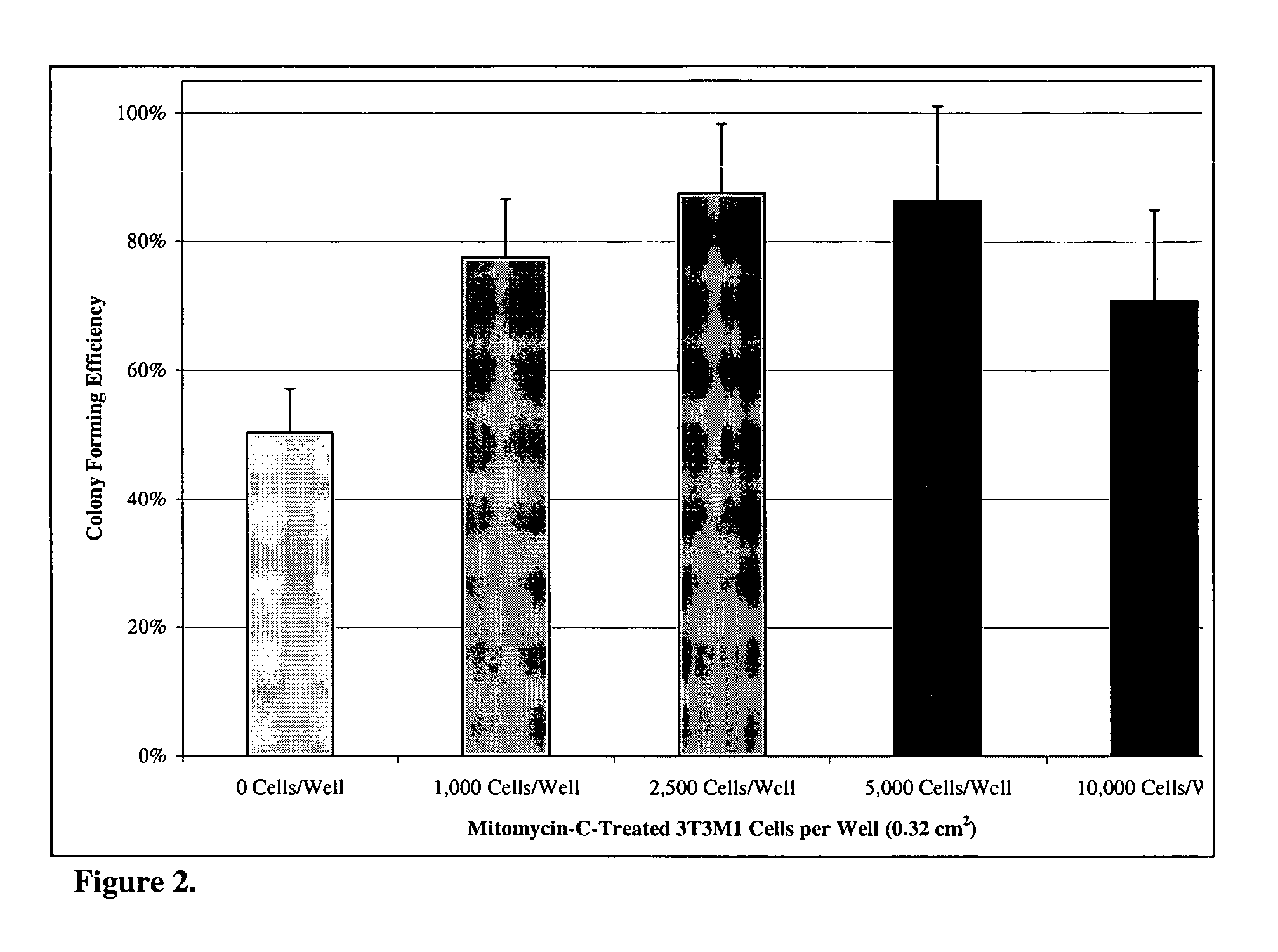Skin substitutes with improved purity
a skin substitute and purity technology, applied in the field of cultured skin substitutes, can solve the problems of complex treatment of severely wounded skin, low purity of cultured skin, and compromise the health and well-being of patients
- Summary
- Abstract
- Description
- Claims
- Application Information
AI Technical Summary
Benefits of technology
Problems solved by technology
Method used
Image
Examples
example 1
Detection of Mouse-Specific DNA Using Mouse Primers ST051 and ST052
[0102] This example describes the detection of mouse-specific DNA using the mouse primers ST051 and ST052. Genomic DNA was isolated from mouse (3T3) and normal human dermal fibroblast (NHDF) cells for use as PCR templates. PCR primers ST051 (5′-GAATTCACTATGAAAGTCAGATTAGATC-3′; SEQ ID NO:1) and ST052 (5′-GAATTCCATAACCATTACAGTTGGCCAACC-3′; SEQ ID NO:2) were designed to amplify a 285 base pair (bp) product specific to mouse genomic DNA (MacGregor, H. C. and Varley, J. M. (1988). “Working with Animal Chromosomes,” 2nd ed., Wiley, N.Y.).
[0103] PCR reactions contained mouse cell (3T3) genomic DNA (123 ng / reaction) or human cell (NHDF) genomic DNA (100 ng / reaction). Following denaturation at 95° C. for 4 minutes, samples were subjected to the following for 35 cycles: Denaturation at 94° C. for 1 minute, Annealing at 50° C. for 1 minute, Extension at 72° C. for 2 minutes. A final extension at 72° C. for 7 minutes was follo...
example 2
Detection of Human-Specific DNA Using Control PCR Primers ST047 and ST035
[0105] This example describes the use of a second set of primers (ST047 (5′-GCCCGGCCCCTCTTGTCCCC-3′; SEQ ID NO:3) and ST035 (5′-GAGCCGGGGTCATCCGGTG-3′; SEQ ID NO:4) to amplify a 500 bp specific product from human genomic DNA. This example also describes the systematic evaluation and identification of optimal primer-template annealing conditions for both mouse and control PCR primer sets.
[0106] PCR reactions contained either human genomic DNA (Promega, Madison, Wis.) (0.5 μg / reaction), mouse cell (3T3) genomic DNA (250 μg / reaction), or human genomic DNA (Promega) (0.5 μg / reaction)+mouse cell (3T3) genomic DNA spike (250 μg / reaction). Following denaturation at 95° C. for 5 minutes, samples were subjected to the following for 30 cycles: Denaturation at 94° C. for 1 minute, Annealing conditions ranging 50° C.-70° C. for 1 minute, Extension at 72° C. for 2 minutes. A final extension at 72° C. for 7 minutes was fol...
example 3
PCR Using Skin Culture Biopsy Samples
[0109] This example describes the isolation of genomic DNA from STRATAGRAFT (Stratatech Corp., Madison, Wis.) biopsy samples for evaluation as a genomic DNA template source in the PCR assays described in Examples 1 and 2. Total genomic DNA was isolated from pooled (MacGreagor, H. C. (1988) In: Working with Animal Chromosomes, 2nd Ed., Wiley, N.Y.) biopsy punches from the same STRATAGRAFT and used as a template for PCR amplification using control primers ST047 and ST035.
[0110] Genomic DNA templates for PCR reactions were one of the following: mouse cell (3T3) genomic DNA; human cell (NIKS) genomic DNA; human genomic DNA (Promega) (0.5 μg / reaction); human genomic DNA (Promega) (0.5 μg / reaction)+mouse cell (3T3) genomic DNA spike (range 10-250 pg / reaction); STRATAGRAFT genomic DNA (0.5 μg / reaction).
[0111] Following denaturation at 95° C. for 5 minutes, samples were subjected to the following for 30 cycles: Denaturation at 94° C. for 1 minute, Ann...
PUM
| Property | Measurement | Unit |
|---|---|---|
| time | aaaaa | aaaaa |
| time | aaaaa | aaaaa |
| concentration | aaaaa | aaaaa |
Abstract
Description
Claims
Application Information
 Login to View More
Login to View More - R&D
- Intellectual Property
- Life Sciences
- Materials
- Tech Scout
- Unparalleled Data Quality
- Higher Quality Content
- 60% Fewer Hallucinations
Browse by: Latest US Patents, China's latest patents, Technical Efficacy Thesaurus, Application Domain, Technology Topic, Popular Technical Reports.
© 2025 PatSnap. All rights reserved.Legal|Privacy policy|Modern Slavery Act Transparency Statement|Sitemap|About US| Contact US: help@patsnap.com



